SNVSAA6A February 2015 – March 2015 LMR14050
PRODUCTION DATA.
- 1 Features
- 2 Applications
- 3 Description
- 4 Simplified Schematic
- 5 Revision History
- 6 Pin Configuration and Functions
- 7 Specifications
-
8 Detailed Description
- 8.1 Overview
- 8.2 Functional Block Diagram
- 8.3
Feature Description
- 8.3.1 Fixed Frequency Peak Current Mode Control
- 8.3.2 Slope Compensation
- 8.3.3 Sleep-mode
- 8.3.4 Low Dropout Operation and Bootstrap Voltage (BOOT)
- 8.3.5 Adjustable Output Voltage
- 8.3.6 Enable and Adjustable Under-voltage Lockout
- 8.3.7 External Soft-start
- 8.3.8 Switching Frequency and Synchronization (RT/SYNC)
- 8.3.9 Over Current and Short Circuit Protection
- 8.3.10 Overvoltage Protection
- 8.3.11 Thermal Shutdown
- 9 Application and Implementation
- 10Power Supply Recommendations
- 11Layout
- 12Device and Documentation Support
- 13Mechanical, Packaging, and Orderable Information
Package Options
Mechanical Data (Package|Pins)
- DDA|8
Thermal pad, mechanical data (Package|Pins)
- DDA|8
Orderable Information
7 Specifications
7.1 Absolute Maximum Ratings
over operating free-air temperature range (unless otherwise noted) (1)| MIN | MAX | UNIT | ||
|---|---|---|---|---|
| Input Voltages | VIN, EN to GND | -0.3 | 44 | V |
| BOOT to GND | -0.3 | 49 | ||
| SS to GND | -0.3 | 5 | ||
| FB to GND | -0.3 | 7 | ||
| RT/SYNC to GND | -0.3 | 3.6 | ||
| Output Voltages | BOOT to SW | 6.5 | V | |
| SW to GND | -3 | 44 | ||
| TJ | Junction temperature | -40 | 150 | °C |
| Tstg | Storage temperature | -65 | 150 | °C |
(1) Stresses beyond those listed under Absolute Maximum Ratings may cause permanent damage to the device. These are stress ratings only, which do not imply functional operation of the device at these or any other conditions beyond those indicated under Recommended Operating Conditions. Exposure to absolute-maximum-rated conditions for extended periods may affect device reliability.
7.2 ESD Ratings
| PARAMETER | DEFINITION | VALUE | UNIT | |
|---|---|---|---|---|
| V(ESD) | Electrostatic discharge | Human body model (HBM)(1) | 2 | kV |
| Charged device model (CDM)(2) | 0.5 | |||
(1) JEDEC document JEP155 states that 500-V HBM allows safe manufacturing with a standard ESD control process.
(2) JEDEC document JEP157 states that 250-V CDM allows safe manufacturing with a standard ESD control process.
7.3 Recommended Operating Conditions
over operating free-air temperature range (unless otherwise noted)| MIN | MAX | UNIT | ||
|---|---|---|---|---|
| Buck Regulator | VIN | 4 | 40 | V |
| VOUT | 0.8 | 28 | ||
| BOOT | 45 | |||
| SW | -1 | 40 | ||
| FB | 0 | 5 | ||
| Control | EN | 0 | 40 | V |
| RT/SYNC | 0 | 3.3 | ||
| SS | 0 | 3 | ||
| Frequency | Switching frequency range at RT mode | 200 | 2500 | kHz |
| Switching frequency range at SYNC mode | 250 | 2300 | ||
| Temperature | Operating junction temperature, TJ | -40 | 125 | °C |
7.4 Thermal Information
| THERMAL METRIC(1) | DDA | UNIT | |
|---|---|---|---|
| 8 PINS | |||
| RθJA | Junction-to-ambient thermal resistance | 42.5 | °C/W |
| ψJT | Junction-to-top characterization parameter | 9.9 | |
| ψJB | Junction-to-board characterization parameter | 25.4 | |
| RθJC(top) | Junction-to-case (top) thermal resistance | 56.1 | |
| RθJC(bot) | Junction-to-case (bottom) thermal resistance | 3.8 | |
| RθJB | Junction-to-board thermal resistance | 25.5 | |
(1) For more information about traditional and new thermal metrics, see the IC Package Thermal Metrics application report, SPRA953.
7.5 Electrical Characteristics
Limits apply over the recommended operating junction temperature (TJ) range of -40°C to +125°C, unless otherwise stated. Minimum and Maximum limits are specified through test, design or statistical correlation. Typical values represent the most likely parametric norm at TJ = 25°C, and are provided for reference purposes only. Unless otherwise specified, the following conditions apply: VIN = 4.0 V to 40 V| PARAMETER | TEST CONDITION | MIN | TYP | MAX | UNIT | |
|---|---|---|---|---|---|---|
| POWER SUPPLY (VIN PIN) | ||||||
| VIN | Operation input voltage | 4 | 40 | V | ||
| UVLO | Under voltage lockout thresholds | Rising threshold | 3.5 | 3.7 | 3.9 | V |
| Hysteresis | 285 | mV | ||||
| ISHDN | Shutdown supply current | VEN = 0 V, TA = 25°C, 4.0 V ≤ VIN ≤ 40 V | 1.0 | 3.0 | μA | |
| IQ | Operating quiescent current (non- switching) | VFB = 1.0 V, TA = 25°C | 40 | μA | ||
| ENABLE (EN PIN) | ||||||
| VEN_TH | EN Threshold Voltage | 1.05 | 1.20 | 1.38 | V | |
| IEN_PIN | EN PIN current | Enable threshold +50 mV | -4.6 | μA | ||
| Enable threshold -50 mV | -1.0 | |||||
| IEN_HYS | EN hysteresis current | -3.6 | μA | |||
| EXTERNAL SOFT-START | ||||||
| ISS | SS pin current | TA = 25°C | 3 | μA | ||
| VOLTAGE REFERENCE (FB PIN) | ||||||
| VFB | Feedback voltage | TJ = 25°C | 0.744 | 0.750 | 0.756 | V |
| TJ = -40°C to 125°C | 0.735 | 0.750 | 0.765 | V | ||
| HIGH-SIDE MOSFET | ||||||
| RDS_ON | On-resistance | VIN = 12 V, BOOT to SW = 5.8 V | 90 | 180 | mΩ | |
| High-side MOSFET CURRENT LIMIT | ||||||
| ILIMT | Current limit | VIN = 12 V, TA = 25°C, Open Loop | 6.2 | 7.9 | 9.7 | A |
| THERMAL PERFORMANCE | ||||||
| TSHDN | Thermal shutdown threshold | 170 | °C | |||
| THYS | Hysteresis | 12 | ||||
7.6 Switching Characteristics
over operating free-air temperature range (unless otherwise noted)| PARAMETER | TEST CONDITION | MIN | TYP | MAX | UNIT | |
|---|---|---|---|---|---|---|
| fSW | Switching frequency | RT = 49.9 kΩ, 1% accuracy | 400 | 500 | 600 | kHz |
| VSYNC_HI | SYNC clock high level threshold | 1.7 | V | |||
| VSYNC_LO | SYNC clock low level threshold | 0.5 | ||||
| TSYNC_MIN | Minimum SYNC input pulse width | Measured at 500 kHz, VSYNC_HI > 3 V, VSYNC_LO < 0.3 V | 30 | ns | ||
| TLOCK_IN | PLL lock in time | Measured at 500 kHz | 100 | µs | ||
| TON_MIN | Minimum controllable on time | VIN = 12 V, BOOT to SW = 5.8 V, ILoad = 1 A | 75 | ns | ||
| DMAX | Maximum duty cycle | fSW = 200 kHz | 97 | % | ||
7.7 Typical Characteristics
Unless otherwise specified the following conditions apply: VIN = 12 V, fSW = 300 kHz, L = 6.5 µH, COUT = 47 µF x 4, TA = 25°C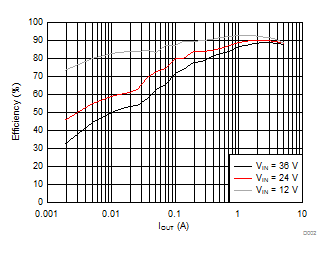
| VOUT = 5 V | fSW = 500 kHz |
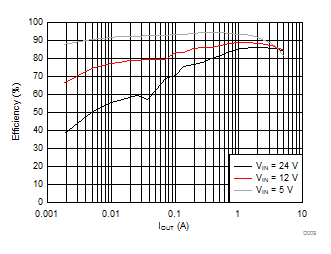
| VOUT = 3.3 V | fSW = 1 MHz |
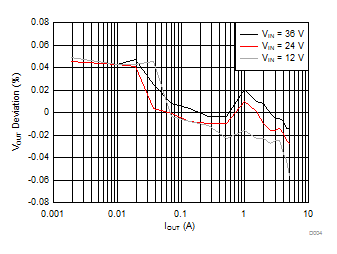
| VOUT = 5 V | fSW = 500 kHz |
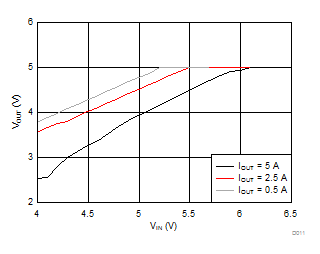
| VOUT = 5 V | fSW = 500 kHz |
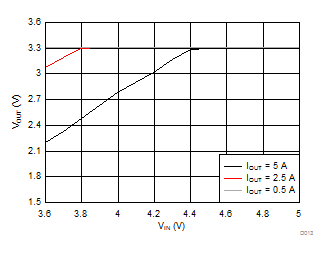
| VOUT = 5 V | fSW = 2.2 MHz |
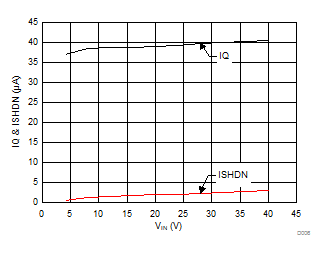
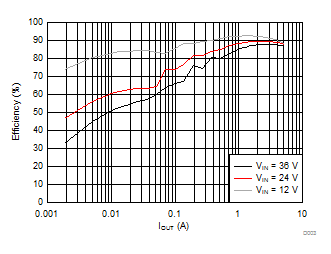
| VOUT = 5 V | fSW = 1 MHz |
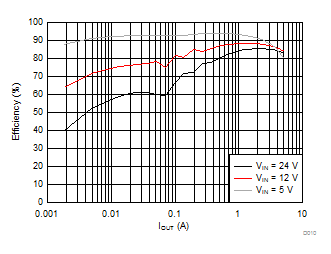
| VOUT = 3.3 V | fSW = 2.2 MHz |
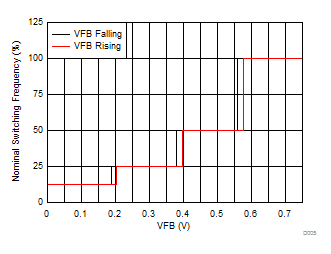
| VOUT = 5 V | fSW = 500 kHz |
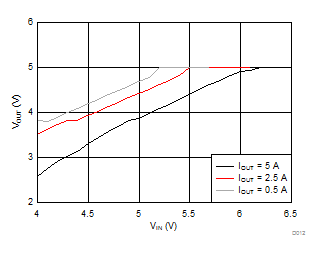
| VOUT = 5V | fSW = 1 MHz |
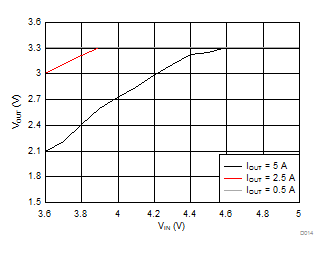
| VOUT = 3.3 V | fSW = 2.2 MHz |
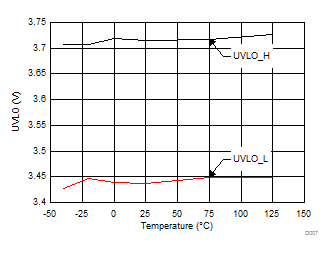
| IOUT = 0 A |